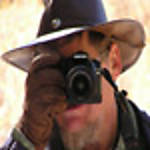 |
The Hull (cont.) |
The very prominent semi-circular final drive units are missing on the tank. Using the photos and measurements that I had taken 2 were made on my lathe using lime wood and detailed with f/g nuts and bolt heads. (All of the bolt heads etc. were made of f/g resin by making a silicon mould of 8, 10, 12 and 14 BA nuts and bolts and pouring the f/g into the finished mould. Very fiddly and lots of misshape were made before getting the knack). A cast effect was applied (as was throughout the entire rebuild) by applying Gunze Sanyo Mr Finisher 500 and then stippling with a short bristled brush, 3-4 coats were applied to give the very rough cast in some areas e.g. the turret mantle and the hull mg housing. (The effect of rolled plate armour was also created by using this method except when dry most of the casting effect was sanded off leaving an irregular flat pitted surface.)
A new mould was made from one of the supplied towing hooks that I had reworked and 4 new hooks were. I also made 4 of the small clips that were designed to prevent the tow ropes coming off of the hooks and fixed 2 of each to the bottom rear plate. As the sides of the hull are exposed and very bare, I made masters of both the axle limiting flange and its locating plate from which silicon moulds were taken. Each axle was then fitted (after filing off mould lines and general cleaning) it’s limiting flange and the locating plate pieces were fixed to the hull.
Each road wheel was turned down on the lathe removing all of the misshaped detail and the edges of the wheels trued. This took days! As the castings were so poor hard epoxy car body filer had to be used to fill the low spots and then returned to the lathe for shaping. I made a master of the wheel centres and also of the wheel hubs. Again using silicon and once set g/f resin, all wheels were given new bolt detail and new hubs. As I wanted an engineered fixing (not easy epoxy) of the wheels to their axles, holes were drilled through the centre axle (between each pair of wheels) and tapped. Aluminium spacers were made, aligned, drilled and tapped and each wheel retained to its axle by this method with a cap head screw. A similar but beefier method was designed and used on the idler wheels.
The drive wheels (not sprockets, I was told once sprockets have teeth), are equally poorly cast. Moreover the actual drive of the T34 is for the track horns to be driven via pulley style wheels within the drive wheels. On the ‘as supplied’ drive wheel the track horns (of alloy) would be engaged by the threads of the hardened steel bolts that pass through the drive wheels. Crazy! A do it yourself milling machine! I replaced the original steel bolts (the excess having been ‘hacked off’ at manufacture also badly damaging the detail on the face of the wheel) and I sheathed each driving portion of the thread with a bronze pulley wheel a la’ 1:1 T34. Both the drive wheels and the idlers received the same lathe/car body filler treatment as the road wheels. Additionally the drive wheels were detailed with scale pin locking devices and new hubs. All of the wheels received 2 coats of acrylic auto grey primer followed by 2 coats of Russian Green. The hull then was then primed and finish painted, the wheels reassembled on to their axles, the gearbox fitted and the drive wheels located.
Unlike the Panther the removable rubber tyres on the road wheels are good, of a hard well formed rubber. They are unfortunately 3mm too narrow and it shows! I purchased 25 feet of 9mm by 3mm hard rubber from a local supplier and made the tyres 3 mm wider on each wheel. This again took some time in view of the need for precise measurement and cutting. The new tyres were left off of the wheels until the weathering had been completed. |
| Project Photos

No method of idler adjuster is provided by the
manufacturer. As 2 links need to removed/added to achieve the correct
track tension, a system using tapped brass bar, furniture brackets and
cap headed screws was devised. G/f yet to be added.

The drive wheel. As supplied, the excess 6mm bolts
that engage the track horns are just cut off with a saw. (New bolts
fitted). Bronze pulleys made to cover the bolt threads to prevent the
bolt threads 'chewing' away the track horns.

The now scale drive wheel. Bronze pulley wheels
now fitted over the steel driving bolt threads. Very poor original
engineering!

Very, very poorly cast road wheels. Held on to the
axle by epoxy glue! The wheels will be removed by using heat, cleaned,
new detail fitted and a method devised similar to the idler wheel to
re-fix to the axle.

The re-profiled road wheels, rubber tyres to be
added after painting. All poorly cast wheel detail lathed off. New wheel
detail, false suspension units and wheel bosses from silicon moulds and
g/f resin.

Remade to scale idler wheel. Original method of
fixing by epoxy burnt out, new securing method using cap head screws and
tapped spacers.

The idler wheel securing system. The mounting
access holes in the wheel rim will be filled prior to painting.
|
|

















